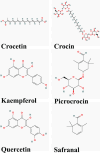An overview of pharmacological effects of Crocus sativous and its constituents
- PMID: 38419885
- PMCID: PMC10897555
- DOI: 10.22038/IJBMS.2023.73410.15950
An overview of pharmacological effects of Crocus sativous and its constituents
Abstract
Crocus sativus L. was used for the treatment of a wide range of disorders in traditional medicine. Due to the extensive protective and treatment properties of C. sativus and its constituents in various diseases, the purpose of this review is to collect a summary of its effects, on experimental studies, both in vitro and in vivo. Databases such as PubMed, Science Direct, and Scopus were explored until January 2023 by employing suitable keywords. Several investigations have indicated that the therapeutic properties of C. sativus may be due to its anti-oxidant and anti-inflammatory effects on the nervous, cardiovascular, immune, and respiratory systems. Further research has shown that its petals also have anticonvulsant properties. Pharmacological studies have shown that crocetin and safranal have anti-oxidant properties and through inhibiting the release of free radicals lead to the prevention of disorders such as tumor cell proliferation, atherosclerosis, hepatotoxicity, bladder toxicity, and ethanol induced hippocampal disorders. Numerous studies have been performed on the effect of C. sativus and its constituents in laboratory animal models under in vitro and in vivo conditions on various disorders. This is necessary but not enough and more clinical trials are needed to investigate unknown aspects of the therapeutic properties of C. sativus and its main constituents in different disorders.
Keywords: Crocetin; Crocin; Crocus sativus; Pharmacological action; Saffron; Safranal.
Conflict of interest statement
The authors declare that they have no conflicts of interest.
Figures
Similar articles
-
The effects of Crocus sativus (saffron) and its constituents on nervous system: A review.Avicenna J Phytomed. 2015 Sep-Oct;5(5):376-91. Avicenna J Phytomed. 2015. PMID: 26468457 Free PMC article. Review.
-
Interaction of saffron and its constituents with Nrf2 signaling pathway: A review.Iran J Basic Med Sci. 2022 Jul;25(7):789-798. doi: 10.22038/IJBMS.2022.61986.13719. Iran J Basic Med Sci. 2022. PMID: 36033950 Free PMC article. Review.
-
A review of therapeutic impacts of saffron (Crocus sativus L.) and its constituents.Physiol Rep. 2023 Aug;11(15):e15785. doi: 10.14814/phy2.15785. Physiol Rep. 2023. PMID: 37537722 Free PMC article. Review.
-
The Pharmacological Activities of Crocus sativus L.: A Review Based on the Mechanisms and Therapeutic Opportunities of its Phytoconstituents.Oxid Med Cell Longev. 2022 Feb 14;2022:8214821. doi: 10.1155/2022/8214821. eCollection 2022. Oxid Med Cell Longev. 2022. PMID: 35198096 Free PMC article. Review.
-
Therapeutic effects of saffron (Crocus sativus L.) in digestive disorders: a review.Iran J Basic Med Sci. 2016 May;19(5):455-69. Iran J Basic Med Sci. 2016. PMID: 27403251 Free PMC article. Review.
Cited by
-
Saffron (Crocus sativus) and its constituents in ovalbumin-induced asthma model: a preclinical systematic review and meta-analysis.Front Pharmacol. 2024 Sep 4;15:1436295. doi: 10.3389/fphar.2024.1436295. eCollection 2024. Front Pharmacol. 2024. PMID: 39295946 Free PMC article.
References
-
- Saeidnia S. future position of Crocus sativus as a valuable medicinal herb in phytotherapy. Pharmacogn J. 2012;27:71–71.
-
- Boskabady MH, Farkhondeh T. Antiinflammatory, antioxidant, and immunomodulatory effects of Crocus sativus and its main constituents. Phytother Res. 2016;30:1072–1094. - PubMed
Publication types
LinkOut - more resources
Full Text Sources

